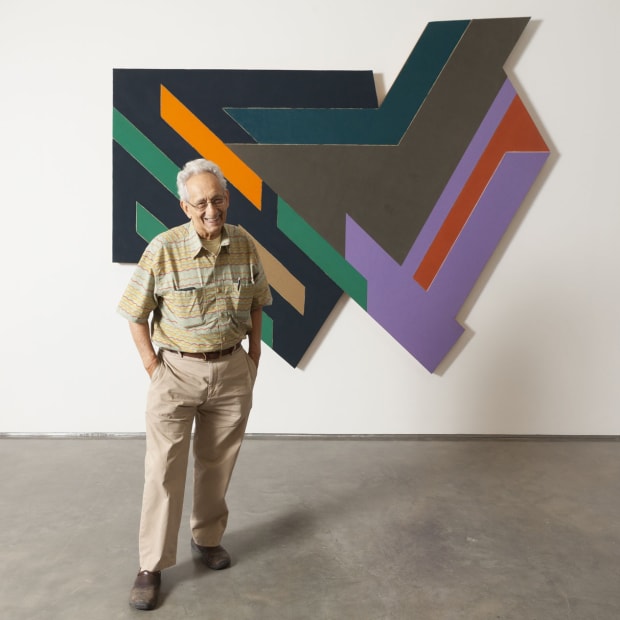Marianne Boesky Gallery is saddened to announce that Frank Stella passed away on May 4, 2024 at the age of 87. A giant of post-war abstract art, Stella’s extraordinary, perpetually evolving oeuvre investigated the formal and narrative possibilities of geometry and color and the boundaries between painting and objecthood.
Stella was born in Malden, MA in 1936. He attended Phillips Academy Andover, where he studied painting under Patrick Morgan, and Princeton University, where he studied history and painting under Stephen Greene and Willliam Seitz. In 1958, Stella moved to New York, rising to prominence in the early 1960s with his austere Black Paintings and innovative shaped canvases—his early work was included in a number of significant exhibitions that would come to define art of the postwar era, including Sixteen Americans at the Museum of Modern Art in 1959, Geometric Abstraction at the Whitney Museum of American Art in 1962, The Shaped Canvas and Systemic Painting at the Guggenheim in 1964 and 1966, respectively, and Structure of Color at the Whitney in 1971.
In the decades that followed, Stella continued to iterate on ideas of form, geometry, and abstraction across mediums and genres. Breaking the confines of recognizable forms, Stella moved beyond two-dimensional painted and shaped canvases into the three-dimensional realm of sculpture and architecture, experimenting with material and surfaces and engaging with cultural histories and literary traditions. “Abstraction,” Stella once said, “didn't have to be limited to a kind of rectilinear geometry or even a simple curve geometry. It could have a geometry that had a narrative impact. In other words, you could tell a story with the shape. It wouldn't be a literal story, but the shapes and the interaction of the shapes and colors would give you a narrative sense. You could have a sense of an abstract piece flowing along and being part of an action or activity.”
From his early contributions to Minimalism—"what you see,” he famously said, “is what you see"—to his expressionistic Moby Dick works to his recent, monumental star forms, Stella was a force in perpetual motion. Throughout his career, Stella was constantly iterating on his own ideas and looking for new sources of inspiration—in literature, in history, in music. The influence of Stella’s many artistic innovations—his explorations of geometry and color, his shaped canvases, his integration of painting and sculpture, his investigations into computer modeling and 3D printing—are visible in the work of his contemporaries and in every generation of artists since. Yet, even amidst his constant drive forward, Stella never shied from an opportunity to look back, to honor his early work and those who came before him. Marianne Boesky began representing Stella in 2014, and the gallery is deeply grateful for a decade of collaboration with the artist and his studio. “It has been a great honor to work with Frank for this past decade,” Boesky said. “His is a remarkable legacy, and he will be missed.”
Beginning in the 1990s and continuing into recent years, Stella employed computer modeling and 3D printing in his perpetual quest to push his work into new compositional and formal realms. His experimentation with line, color, and form, aided by innovative modeling techniques, resulted in new work, often on a monumental scale, that pushed his practice forward while recalling colors, forms, and visual motifs that appeared throughout his career—from stars and ribbons to the stark minimal purity of his early Black, Aluminum, and Copper paintings.
Stella’s prolific oeuvre was the subject of countless museum and gallery exhibitions over the course of his career. A major retrospective, organized by the Whitney Museum of American American Art in 2015 traveled to the Modern Art Museum of Fort Worth, TX and the de Young, San Francisco, CA. He was the subject of two Museum of Modern Art retrospectives, one in 1987 and one in 1970, when he was just 34 years old. His work is in the collections of numerous renowned public collections, including the Art Institute of Chicago, IL; the Baltimore Museum of Art, MD; the Brooklyn Museum, NY; the Dallas Museum of Art, TX; the Denver Museum of Art, CO; the Detroit Institute of Arts, MI; the Hirshhorn Museum and Sculpture Garden, Washington, D.C.; the Los Angeles County Museum of Art, CA; the Metropolitan Museum of Art, NY; the Museum of Modern Art, NY; the Museum of Fine Arts, Boston, MA; the National Gallery of Art, Washington, D.C.; the Philadelphia Art Museum, PA; the St. Louis Art Museum, MO; the San Francisco Museum of Modern Art, CA; and the Whitney Museum of American Art, NY, among many others. One of Stella’s final works, Jacksonville Stacked Stars (2023), commissioned in celebration of the 100th anniversary of the Museum of Contemporary Art Jacksonville, is currently on view in the museum’s grand atrium.
 Photo: Kristine LarsenMarianne Boesky Gallery is saddened to announce that Frank Stella passed away on May 4, 2024 at the age of 87. A giant of post-war abstract art, Stella’s extraordinary, perpetually evolving oeuvre investigated the formal and narrative possibilities of geometry and color and the boundaries between painting and objecthood.
Photo: Kristine LarsenMarianne Boesky Gallery is saddened to announce that Frank Stella passed away on May 4, 2024 at the age of 87. A giant of post-war abstract art, Stella’s extraordinary, perpetually evolving oeuvre investigated the formal and narrative possibilities of geometry and color and the boundaries between painting and objecthood. Photo: Kristine Larsen
Photo: Kristine Larsen
